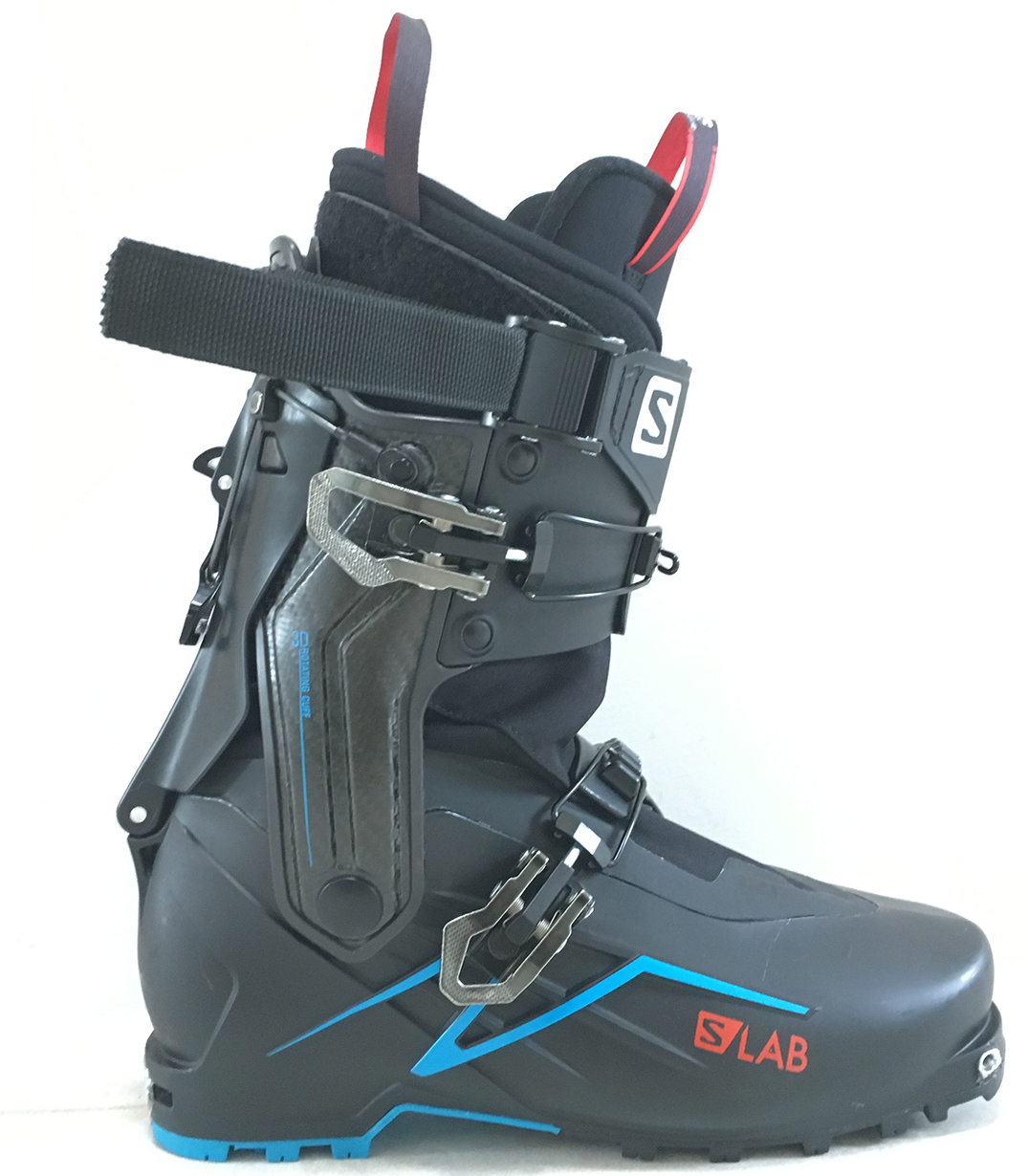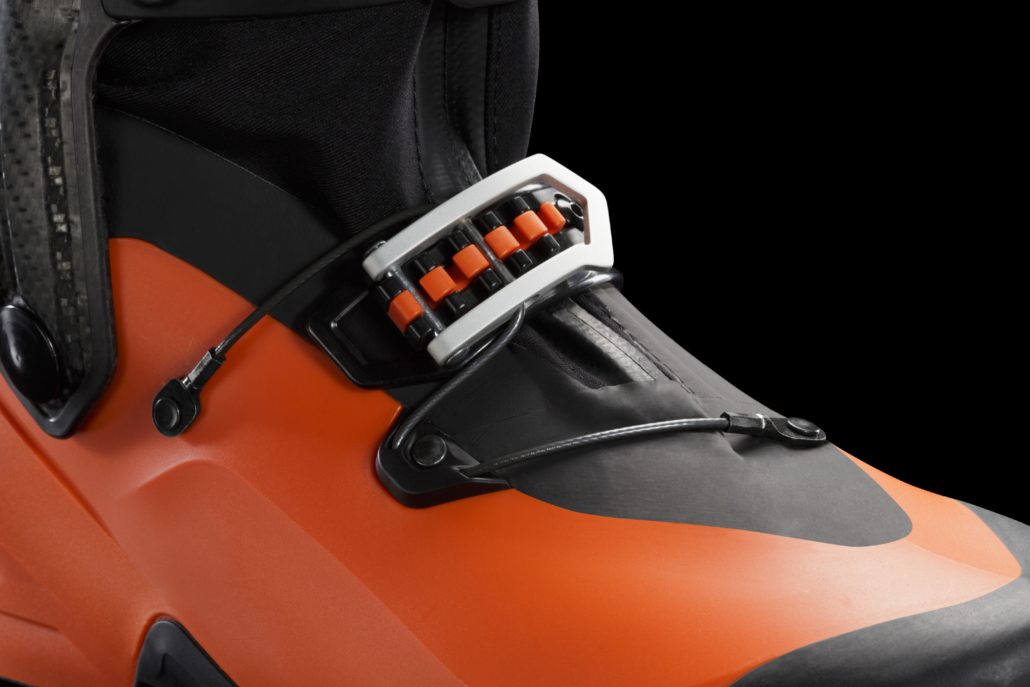
2019-2020 Salomon S/Lab X-Alp
Size Tested: 28.5 / 305 mm Boot Sole Length
Stated Weight (27.5): 1150 g
Blister’s Measured Weight (28.5):
• Shells & Boot Boards, no Liners: 1010 g each
• Liners (with laces, no spoilers, no footbeds): 222 g each
• Total Weight per Boot: 1232 g each
Shell Material: Grilamid with carbon fiber reinforcement
Binding Compatibility: Pin-style “tech” bindings with a pin heel
MSRP: $899
Days Tested: 5
Test Location: Chugach Backcountry, Alaska
[Note: Our review was conducted on the 17/18 S/Lab X-Alp, which was not changed for 18/19 or 19/20.]
Introduction
Salomon introduced the X-Alp earlier this winter as a new ultralight touring boot for 2017-2018. As Jonathan and Cy pointed out in their First Look at the boot back in March, it is based on the same shell as the 2016-2017 Arc’teryx Procline with a few differences that are intended to make the X-Alp more ski-touring focused than the Procline (which is more ski-mountaineering oriented than the X-Alp).
Jonathan and Cy did an excellent job of introducing the boot, then Jonathan posted up a Flash Review with his initial impressions. So please take look at those pieces before you read this since I’ll be referencing them.
Available Editions of the X-Alp
The X-Alp will be available in both an “S/Lab” version and an “Explore” version. Both Jonathan and I have skied the more expensive (MSRP $899) carbon-fiber reinforced S/Lab version, and both of our reviews reflect that. But I also skied one day in the Explore version of the X-Alp which I’ll talk about at the bottom of the review. Similar to the Salomon MTN series (which includes the Salomon MTN Lab and. MTN Explore), the S/Lab and Explore versions of the X-Alp are similar in appearance and design, but offer quite different in skiing experience.
Fit
Note: as always, we strongly recommend getting your boots from a reputable boot fitter. That’s the best way to ensure that you end up in a boot that works for your foot.
Before I got into the Arc’teryx Procline, it was my understanding that I should ski it in my regular size, which is 27.5. So, despite having had to bump up to 28.5 in the Dynafit TLT series, I started with the Procline in 27.5. While I enjoyed the excellent heel hold and performance fit of the 27.5, I ultimately decided that I would have been better off with the 28.5, as I was never able to get them comfortable enough for extended touring and hiking.
So when I learned that the X-Alp was based on the same shell as the Procline, it was an easy decision to bump up to the 28.5, and I’m glad I did. Doing so resulted in a small sacrifice in heel and ankle hold, but it made the boots much more comfortable for extended days of touring — especially when those days included a fair amount of hiking and scrambling without skis on. The heel and ankle hold remained good enough that I could still skin with all of the buckles open with only minimal heel movement.
Jonathan mentioned his concerns that the instep felt a little low in these boots, and I would echo that sentiment, since I also have a relatively high instep. With the stock X-Alp liner, I experienced moderate instep pressure. This was alleviated somewhat when I skied them with a set of Intuition Powerwrap Pro liners, and I think I can make those work for extended touring. But it will require a little more liner work. It’s worth noting that the lower buckle of the boot exerts pressure directly over the highest part of my instep which compounds this issue for me.
I often require a “6th toe” punch in the lower shell of my boots (including the MTN Lab in a 27.5) but, so far, I have not found need for that in the X-Alp.
Liner

The S/Lab X-Alp liner is very similar to the Arc’teryx Procline Support liner, which I covered in my Procline review. The only notable differences are that the flex zone at the achilles area is shaped a little differently, and the footbed section of the Salomon liner is sewn on instead of glued on like that of the Arc’teryx. I also think the the Arc’teryx liner’s sole area is a tiny bit thinner than the X-Alp’s, and it feels like this provides a touch more vertical space for my higher instep with the Arc’teryx.
Both the Procline and X-Alp liners remind me of the Scarpa (Intuition) Pro-tour style liners (like those included with the Scarpa F1) with the exception that the foam in the Salomon/Arc’teryx liners does not feel as stiff and supportive to me, and doesn’t seem to heat mold as effectively.
My favorite feature of the Procline and the X-Alp Liners is the very cool lacing system that utilizes a single strip of thin webbing and a hook and loop closure at the top. It’s simple, effective, and low profile, and I’d be happy to have that lacing system on any boot liner I own.
Buckles / Power Straps
I generally don’t like lower shell buckles that are easily opened or damaged when traveling in deep snow or walking around in rocks and vegetation.
The X-Alp lower buckle is, unfortunately, placed in such a way as to be quite exposed to this kind of damage and unintentional opening. While I haven’t damaged mine yet, I have had them open up on me several times when scrambling around in scree and while post-holing in hot, sticky, spring conditions. And in this regard, the Arc’teryx Procline design is far superior. The Procline’s lower buckle (with its multiple cable attachment points) also distributes pressure over a little larger area of the shell which I found more comfortable and secure. Overall, I would have much preferred that Salomon had utilized the Procline-style buckle.

The top buckles of the Procline and the X-Alp are quite similar, with the only difference being that the Procline version has the ability to lock into the “open” position, which is a feature I don’t really find to be that useful. In both boots, the top buckle is simple, effective, and functioned well for me.
The power straps on the S/Lab X-Alp and the Procline Carbon are slightly different from each other, but both have a very secure camming style buckle that provide excellent support, is easy to tighten and loosen, and stays tight while skiing.The power strap is a feature that is often overlooked on lightweight touring boots, yet it’s one that I think is very important because a good powerstrap can yield a dramatic improvement in downhill ski performance in these types of two-buckle boots.
Gaiter
Like the Arc’teryx Procline, the X-Alp series utilizes a stretchy textile gaiter to keep out snow and debris, and I found the gaiter to be very functional in both boots. As Jonathan wrote, the X-Alp version does make getting the liner (and to a lesser degree, your foot) into the boot a little tougher, but overall I think it’s a good design and it works as intended. Neither Arc’teryx nor Salomon claim that this textile is waterproof, and after a bunch of creek crossing and wet beach scrambling on ocean-based ski touring missions, I can verify that it isn’t. But both did remarkably well in keeping out most of the water, so long as I didn’t linger too long in the water.
Soles
As Cy and Jonathan pointed out, the rubber soles on the X-Alp are much thinner than those on the Procline. This is likely done in the interest of weight savings, and they appear as if they’ll do fine for mostly snow-based adventures. But I suspect they’ll get pretty beat up during extended use in rocky terrain.
Finally, it’s also worth noting that Salomon jettisoned the rubber toe rand of the Procline, which should also save some weight.
NEXT: Touring, Downhill Performance, Etc.

Very stoked for the deep dive. Any commentary on the foreward lean in these relative other boots in the category? The procline felt pretty far forward, but so does the TLT5P even with the updated spoiler.
Hi Paul, did you ever get around publishing that deep dive?
That should be forthcoming this season. For now, take a look at the other reviews of boots in this category. There should be some valid comparisons noted throughout.
What size shoe do you wear?
Hi Paul
After trashing 2 pairs pf TLT7 Performance I’m thinking of getting a refund and going for the Slab Xalp as my light touring solution. I’m looking forward to the deep dive :)
PS: what do you think, am I using the wrong tools for my all day touring? I’m a dynamic skier, 1,8m, 85kg Adam, skiing an Atomic Backland 96 in 177 with ATK Raider bindings. Given that 2 pairs od TLT7 couldn’t handle too much of me I’m wondering if I need to take another approach… Although, point of the setup was to have a light weight solution that allows for long and demanding touring
Cheers
Adrian
Hi Paul,
Is the Deep Dive available now? I cannot find it. Would really like to know how they compare to the Salomon S/LAB MTN and maybe to some Dynafit boots (Hoji? Vulcan?). But apparently the Salomon MTN is better than the Vulcan (http://blistergearreview.com/gear-reviews/dynafit-vulcan-vs-salomon-mtn-lab/3)
Thanks for all your work, the reviews & deep dive are incredible :-).
Hey Paul, I just ordered a pair of proclines as my first AT splitboard boots, and they have a weird click in their flex. While in ski mode the initial forward flex of the boot the extra space between the bump and the hole it fits into on the back of the boot makes the boot have flex with no resistance, then it goes into the normal flex of the boot. I’ve never seen this before, my hojis don’t do it, my partners’ TLT 6 and 7s don’t do it, and neither do langes I’ve skiied. Do the salomons have this as well? I’m super not stoked on it but I really like the idea of the X-ALPS/Proclines for AT splitboarding. Thanks!